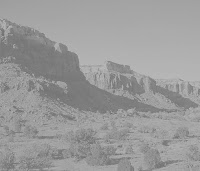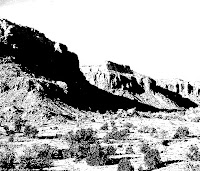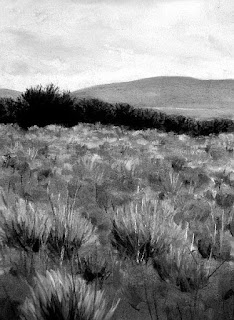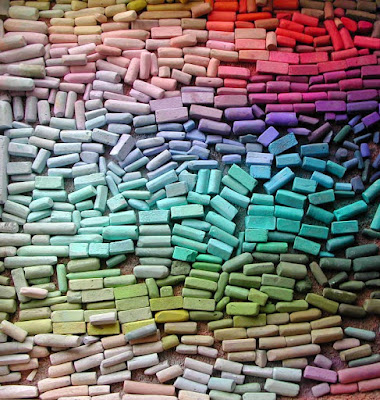(Originally published in The Pastel Journal)
Two very important aspects of painting are influenced by value: color and composition. An understanding of value can free the artist to enhance color, just as an understanding of value masses can strengthen composition.
Value is a basic property of color. Many artists claim it’s the most important aspect of color. Although it’s possible to paint without fully understanding the link between value and color, experienced artists come to understand and use it to their advantage.
Perhaps the easiest way to visualize value is to think of an old black and white television show such as “I Love Lucy.” Ricky and Lucy were real people in living color, but the television presented only the values of these colors. So, simply put, the value of a color is its blackness or whiteness, its darkness or lightness.
In optics, white is comprised of all wavelengths or colors of light, while black is the absence of light. We think of value in terms of black and white because of this optical connection. Black and white are among the darkest and lightest pigments we use, but we can organize an image using the entire range of dark and light values in any color. This is because we organize images by value. If we didn’t, we couldn’t perceive that Lucy was stuffing chocolates in her mouth as fast as she could. If we relied on color for the organization, we couldn’t see Lucy at all. Instead, we rely on dark and light relationships for the images we see. We could still understand an image using the values of red and white, or blue and white, or even yellow and white. Value is specific to the lightness or darkness of any color.
The traditional approach to painting is to begin by using value, followed by color. This tonal approach is a good basic way to organize a painting. Many artists begin with a thumbnail sketch or pencil drawing, then do a charcoal underdrawing right on the paper, which predetermines the value structure beneath the colors. Others will do a grisaille, an underpainting in the values of one color only, usually grays. This is most often done with watercolor or other soluble media so that, when dry, the pastel may be applied on top.
But why begin with black and white when pastel is famous for rich, saturated color? Strengthening the underlying value relationships used to organize paintings strengthens color, which allows you to use color more freely. Select any color as long as it is in the correct value range. You can play with color endlessly, using multiple layers or broken color to achieve the correct value, which energizes your use of color throughout the painting.
It’s necessary to begin to understand values and how to mass them together in a composition to make strong patterns. If you compose using strong value masses, and stay true to them throughout, you’ll achieve a strong painting in color. During the course of a sketch, turn it upside down or sideways occasionally to view it as a design. This defeats the tendency to take verbal shortcuts. The upside down image is a series of shapes rather than named objects.
Look for the shapes defined by masses of similar values. Squint your eyes to lose the details, stand across the room or look into a mirror to see how all of the dark places form one big interlocking piece, as do the lights and the mediums. Rearrange these shapes to achieve a pleasing pattern of values, massed together into a composition.
This is the underlying abstraction of any painting. Abstraction begins when you make a two-dimensional representation of the three-dimensional world. In this way the massing of values helps to strengthen the composition of a painting, just as understanding value strengthens color.
VALUE PALETTE ARRANGEMENT
It’s necessary to learn how to determine the value of a color in a painting. To begin, it might be easiest to organize your palette of pastel sticks into dark, medium and light values. This simple first step will teach a lot about value.
Clean the pastel sticks thoroughly and work in a well-lighted area so that you can see the colors clearly. Put down a piece of clean light-colored paper (paper towels will do), and start by choosing the darkest colors from the jumbled box of pastels. Lay them at one end of the paper, then select all of the lightest colors and lay them at the other end. If there are a lot of pastels, go back to the box again and choose the lightest and darkest colors remaining there, laying these colors inboard of the ones you have already laid out. By looking at the colors left, you’ll still be able to select the darkest and lightest. Do this as many times as you need until you have only medium values left in the box. Place these in the center of the white paper. This gives you a minimum of three values in the newly organized palette ordered from light to dark.
You might want to go on and arrange your colors into rainbow order so that they move from yellow to green to blue, then purple to red to orange. Think of your palette as a grid, with the colors arranged horizontally and the values arranged vertically. In this way you could have a row of yellow arranged horizontally from light on the left to dark on the right, beneath it a row of green from light to dark, then a row of blue, etc. Try to line up the values vertically, so that the lightest yellow, green and blue are loosely in a column, then the medium-dark yellow, green and blue column, then the mediums, etc.
You can make this arrangement of colors as complex or as simple as you like. Arranging your colors into as few as three simple value groups will help you begin to understand their values, whether they’re in rainbow order or not. Now clean your palette box and place your pastels in it in the order you’ve chosen.
Below is my palette arrangement, loosely by color and value. I keep white in the lower left, black in the upper right. You can also see my shapers and foam brush, plus a couple of pastel pencils, on the far right side.
No matter how you set up your palette, be sure it’s organized. Painting is a little like making music: You can’t play well if you don’t know where to find the notes! No matter what palette arrangement you choose, be sure your colors are in predictable places so that you can find the right “notes” repeatedly, without having to grope around. Little pyramids of dusty pastels make the process of finding colors more difficult.
When you’re ready to begin painting you can easily go to one value area in your palette and select several colors in the same or a similar value. By layering these colors over one another, or putting them down side-by-side to achieve “broken color,” you strengthen the color. Rather than a simple dark brown tree trunk you can choose dark values of purple, ochre, green-gray and orange, which together give an illusion of dark brown that’s much more pleasing to the eye. Instead of choosing light gray for a cat’s fur, you can select lavender, green and orange in a medium-light value and layer one over another softly to make a lively and interesting gray. In that white pitcher on the table, use pale values of yellow, pink and green to make all but the lightest of highlights.
To test your color harmonies without risking your painting, it might help to reserve a small section on the side of your image field, which will be matted out or cut off, or fasten a second piece of the paper you are using alongside your painting surface. Here you can experiment with colors, laying them side-by-side to determine their harmony or discord. Colors of the same value painted so their edges touch seem to melt together into one. (See the chapter on Value and Color.) Squint to see this more easily. You’ll find that in different relationships, some colors that seem identical in value in your palette will look awkward or out of place in the context of the painting. For instance, although the values in a mountain range may contain blue, too much blue can make the range appear more distant than you desire. So even though the blue is the perfect value, it might not be the best choice for this part of the painting. In the dark tree trunk it might not be a good idea to use too much dark green, though it is identical in value, because so much of the foliage contains green.
Try to develop a light hand in applying layers of color; use a heavy layer only where you want the unifying force of one predominant color overlaid. There is an exquisite beauty to several light passes with different colors of the same value, which creates subtle or vivid passages in your painting.
It’s worth the time you take to become familiar with the values of colors. Experiment with color harmonies by laying colors of the same or similar values side by side and finding those that melt together visually. Try them on different background colors. See what happens when you feather them with light strokes of charcoal or blend them together using a light glaze of one color over the top. Identify light, medium and dark values that work in concert, compatible colors that resonate together in their value range. Know where they reside in your palette so that you can reach for them with little or no thought, to paint visual music.
As you pay closer attention to the value structure in your paintings, and strengthen the use of layered or broken colors, you’ll begin to see why value is a basic property of color and will be able to make rich use of all the colors in your palette.
VALUE CONTRASTS
What is the role of value contrast in making a painting successful? Without value contrast we have no visual image because our eyes perceive the world via values. That’s the reason we understood what we saw when we watched those old black and white TV shows. But obviously there’s far more to this value contrast business than simply making a picture. Not every painting uses value contrasts to the best advantage. There are some rules we can use to analyze the role of value contrast in painting.
Value contrast creates a composition -- no contrast, no picture. This is true whether there is high or low contrast. If you turn up the contrast you end up with glaring black and white with no effective details, and if you turn it down you end up with all gray.


Conversely, value contrast is most evident when black is next to white. The area where the darkest dark and the lightest light come closest together is the most visually attractive. Thus, strong contrast is useful for controlling attention. The greater the difference, the more attention the area attracts. This is one of the most powerful tools we have to define the area of interest in a painting. You want to create a spot where your viewer is unavoidably drawn, a place where the eye inevitably begins its journey. Remember that this area of highest contrast is only where the eye starts, however.
Value contrasts lead the viewer into and around the painting in an interesting, planned path. By using contrasts effectively, modulating some and highly contrasting others, you can orchestrate the movement of the eye throughout the painting. (Other elements contribute to this, but for now let’s look only at contrasting values and how they work.)
Similar values placed together are not as visually interesting as highly contrasting values, which tend to attract the eye. This means you can compose movement with value. For instance, if the values are paler and more of these grayed values are massed together they will look farther away, while strong dark and light values seem to be closer to us in the construction.
In this painting, reduced to grayscale, notice that the areas where values are almost the same create a sense of distance, while the lighter lights against the strong darks pop forward.
Middle values usually provide the framework for the painting, with light and dark value contrast giving the work its visual impact. In landscape paintings in particular, the middle values tend to be a greater proportion of the construction, with smaller areas of additional high contrast attracting the eye. When the value range is reduced the eye still goes to the area of maximum contrast, but the design loses impact. Even in a painting with low value contrast the eye will still go to the area of highest contrast -- but who cares? In other words, such a painting may become visually boring, hardly worth considering.
 In this grasycale version of a painting you can see that by reducing the value contrast the eye has little or no area of interest, but in the normal contrast there is.
In this grasycale version of a painting you can see that by reducing the value contrast the eye has little or no area of interest, but in the normal contrast there is.
A wider range of tonal values will have a stronger impact. This rule is probably the most important. Creating a wide range of tones is how you construct the composition, controlling the movement of your viewer’s eye, and creating interest in the painting.
You can see that value contrast plays a large part in painting, the most important of which is moving the eye around, manipulating attention. More contrast, more interesting. Less contrast, less interesting. Value contrast is the visual impact of a painting, the oomph, the pizzazz -- or the lack thereof. If your composition lacks enough contrasting values it’s visually boring. Oddly, if your composition is consistently high in contrast all over, it’s also boring. So it isn’t about just upping the contrast to make the painting interesting. Instead you have to control the contrast to move the eye. Create your value structure with well-placed medium values, massed together, providing the underlying organization. Place stronger contrasts in key areas to attract attention, and then modulate the remaining values to induce further movement around the painting.
Morning Faces, 9x12”
Morning Faces, grayscale
















